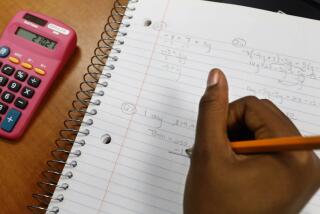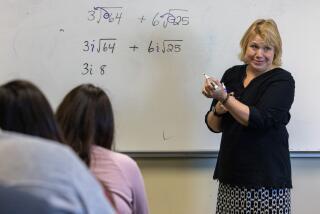Should Algebra Be Part of Graduation Equation?
- Share via
OK, the recipe says it serves four, but you’ve got 11 coming to dinner. Now what?
Few cooks would be stymied by this problem. They’d just use a pinch of . . . algebra?
Yes, algebra, that thing Mr. Whozit in math class said would come in handy sometime.
You may have forgotten the quadratic equation, but because of algebra, you realize your recipe problem is really a simple ratio--11 servings to 4. Just multiply each ingredient by eleven-fourths (or 2.75) and the problem is solved. Instead of one-half teaspoon of salt, you’ll use 1 3/8 teaspoons.
“People do this all the time and don’t think about it as math,” says Sheila Chew, a math teacher at Brea Olinda High School.
At Chew’s school, you pass algebra or you don’t graduate. A similar requirement has just been approved for high school students in the Placentia-Yorba Linda Unified School District.
Most students at most high schools wind up studying algebra, but some educators are pushing to make algebra a universal graduation requirement.
Is this bad news for those who just hate math?
Chew says it may seem so, but consider: “A lot of people don’t know what it means to them until they get out of high school. That’s the whole problem. Most of the jobs are going to need algebra skills. And since most kids don’t know what kind of job they’re going to have, they need it.”
Algebra is a method of stating problems as equations, then determining the unknown quantities. Example: You are allowed $40 in change to stock your cash register but must have the same number of quarters, dimes and nickels. How many of each?
Some say the value of such problems is their training in logical thought. Others, however, say they have day-to-day applications in real life.
To make algebra more palatable to her students than it was to their parents, Chew poses problems that have the ring of real life. One that ignited her last classes’ enthusiasm was the trail-mix problem.
You’re going hiking, and you want to make a batch of trail mix that will supply half your protein requirement and no more than half your fat allowance for the day. All you have are peanuts and raisins. What’s the recipe?
“Nutrition is not a field you expect to see a lot of math in,” Chew says, and perhaps because of that her students threw themselves enthusiastically into the project.
They calculated their personal nutritional needs, then translated that into ingredient measurements. (Answers varied according to students’ weight and activity levels, but a typical answer was 2 1/4 cups of raisins and half a cup of peanuts.)
*
“That sort of stuff is fine as an exercise,” says Wayne Bishop, a Cal State Los Angeles math professor, “but in real life if you want trail mix, you’re going to go down to the Price Club and buy some. If you want to figure interest rates, you’ll use a calculator.
“The real-life applications of algebra? There are none. That’s the short answer and a little facetious, but not far from the truth.”
It may not sound like it, but Bishop is campaigning to preserve pure algebra in schools. He believes its benefits are not what it does for your everyday life but what it does for you--mental discipline, logical thought, an ability to manipulate.
“I don’t know whether people have these skills because they studied algebra or they studied algebra because they have these skills,” Bishop says. “The wisest street kid negotiating complicated drug deals may have these skills without ever studying algebra.”
Whether requiring algebra for high school graduation becomes a trend may be moot. Nowadays, about 80% of high school students expect to continue their schooling after graduation, so they take algebra to meet entrance requirements.
But the other 20% would benefit too, Chew says.
“My main thing to tell kids is they don’t know what they’re going to do. The average person changes careers several times. If you don’t have the skills, you limit yourself.”
By the way, the answer to the cash register problem is 100 each of nickels, dimes and quarters. (The equation: .25x + .10x + .05x = $40)






